|
ΩτοΡινοΛαρυγγολόγος Medicine by Alexandros G. Sfakianakis,Anapafseos 5 Agios Nikolaos 72100 Crete Greece,00302841026182,00306932607174,
Translate
Ετικέτες
Κυριακή 20 Δεκεμβρίου 2020
Clinical and radiological outcome after anterior cruciate ligament reconstruction using the T-lock Osteotrans resorbable tendon anchor: early experience and midterm follow-up
Εγγραφή σε:
Σχόλια ανάρτησης (Atom)
Αρχειοθήκη ιστολογίου
-
►
2023
(278)
- ► Φεβρουαρίου (139)
- ► Ιανουαρίου (139)
-
►
2022
(1962)
- ► Δεκεμβρίου (107)
- ► Σεπτεμβρίου (158)
- ► Φεβρουαρίου (165)
- ► Ιανουαρίου (163)
-
►
2021
(3614)
- ► Δεκεμβρίου (152)
- ► Σεπτεμβρίου (271)
- ► Φεβρουαρίου (64)
- ► Ιανουαρίου (357)
-
▼
2020
(3279)
-
▼
Δεκεμβρίου
(396)
- Integrative Cancer Therapies
- Endocrinology and Diabetes
- Clinical Medicine Insights: Case Reports
- Case Reports in Otolaryngology
- Brain Circulation
- Clinical Pulmonary Medicine
- Melanoma Research
- Health & Fitness
- A&A Practice
- Sports Medicine and Arthroscopy Review
- Critical Illness and Injury Science
- Anatomiy
- Rural Medicine
- Medicine
- Oral Care and Research
- Cancer Research and Therapeutics
- Neurological Sciences and Neurophysiology
- Preventive and Clinical Dental Research
- Medical Journal
- Otolaryngology & Head and Neck Surgery
- Orthopedic Disorders
- Medicine
- HNO
- Otology & Neurotology
- Investigational New Drugs
- Shock
- Fwd: New Articles From Journal of Translational Me...
- Dexmedetomidine Provides Cardioprotection During E...
- Retrograde Autologous Priming in Cardiac Surgery: ...
- The Effects of Nitroglycerin on the Oxytocin Dose–...
- Pediatric Anesthesia Severe Adverse Events Leading...
- Incidence of Anaphylaxis to Sugammadex
- Stickler Syndrome: Airway Complications in a Case ...
- Financial and Clinical Ramifications of Introducin...
- The Attributable Mortality of Postoperative Bleedi...
- Machine Learning Applied to Registry Data: Develop...
- Analgesic Effect of Intraoperative Intravenous S-K...
- Daily Caffeine Consumption Does Not Influence Acup...
- Nonopioid GTS-21 Mitigates Burn Injury Pain in Rat...
- Variation in Patient-Reported Advance Care Prefere...
- Lung Ultrasound Findings in the Postanesthesia Car...
- Barrier Devices, Intubation, and Aerosol Mitigatio...
- Adaptation of an Obstetric Anesthesia Service for ...
- The Clinical Use of Cricoid Pressure: First, Do No...
- Effectiveness of Prone Positioning in Nonintubated...
- The Current State of Combined Pediatric Anesthesio...
- A Developing Nation’s Experience in Using Simulati...
- Decontamination and Reuse of N95 Filtering Facepie...
- Treating patients across European Union borders: A...
- Isthmin1, a secreted signaling protein, acts downs...
- Cancers, Vol. 13, Pages 54: Targeting the Roots of...
- Correlation Between Invasive and Noninvasive Techn...
- Médecine & Droit
- Tropical Medicine
- Hazardous Materials
- Otology
- Acta Medica International
- Anaesthesiology
- Medical Ultrasound
- Eye & Contact Lens
- Spine
- Anesthesia & Analgesia
- Neonatal Care
- Transplantation
- Thoracic Imaging
- Shock
- Pediatric Critical Care Medicine
- Investigative Radiology
- Primary breast cancer patient with poliomyelitis: ...
- Discontinuous polyostotic fibrous dysplasia with m...
- Novel triple therapy for hemorrhagic ascites cause...
- Médecine & droit
- Biological Markers
- Tropical Medicine
- Otolaryngology & Head and Neck Surgery
- Geriatric Physical Therapy
- Lower Genital Tract Disease
- Skin & Wound Care
- Pediatric Critical Care Medicine
- Christian Nursing
- Oncology Times
- Fwd: Read the latest PAIN - Vol. 162, No. 1, Janua...
- Extracorporeal Life Support
- Clinical and Translational Gastroenterology
- Pediatric Physical Therapy
- Clinical Psychopharmacology
- Coronary Artery Disease
- Current Research in Scientific Medicine
- Patient Safety and Infection Control
- Interdisciplinary Dentistry
- Neurosurgical Anesthesiology
- Fwd: Panafrican Medical Journal - Recently Published
- Calcium signaling: breast cancer’s approach to man...
- What Are the Preferences of Patients With Rheumato...
- Development of a Patient-Reported Outcome Measure ...
- Clinical and Economic Burden of Pediatric Mild-to-...
- Two-Year US Pharmacovigilance Report on Brodalumab
- Identification of characteristics, risk factors, a...
- Effects of Heat and Chemical Pretreatments of Bana...
- Clinical and radiological outcome after anterior c...
- ► Σεπτεμβρίου (157)
- ► Φεβρουαρίου (382)
- ► Ιανουαρίου (84)
-
▼
Δεκεμβρίου
(396)
-
►
2019
(11718)
- ► Δεκεμβρίου (265)
- ► Σεπτεμβρίου (545)
- ► Φεβρουαρίου (1143)
- ► Ιανουαρίου (744)
-
►
2017
(2)
- ► Φεβρουαρίου (1)
- ► Ιανουαρίου (1)



Δεν υπάρχουν σχόλια:
Δημοσίευση σχολίου